 |

15 Aug 2013
|
|
Registered Users
HUBB regular
|
|
Join Date: Aug 2007
Location: Australia
Posts: 64
|
|
|
Bali, Lombok, Sumbawa - a motorcycle odyssey. Beyond Bali
Indonesian Odyssey – beyond Bali.
As soon as we walked into the showroom I knew which one Inez was going to choose. There they were, lined up in a neatly spaced row, - Honda Vario scooters - each one a shiny-bright, 110cc, liquid-cooled, automatic, freedom machine. And the brightest of all was the PINK one!
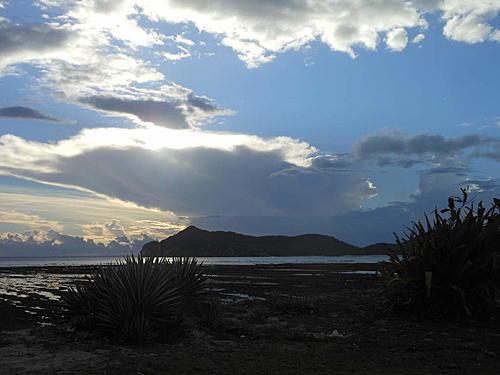
“That one,” she said pointing at ... the pink one! My heart sank. I would be riding this steed on a four week trip east of Bali. “Are you sure?” I queried hopefully. “The red looks good.” But no - pink it was, and the deal was done. A massive wad - 15,700,000 Indonesian Rupiah (AUD $1,800) - was handed over, a sales note signed and the dealer had wrapped up one of the easiest sales she’d ever handled.
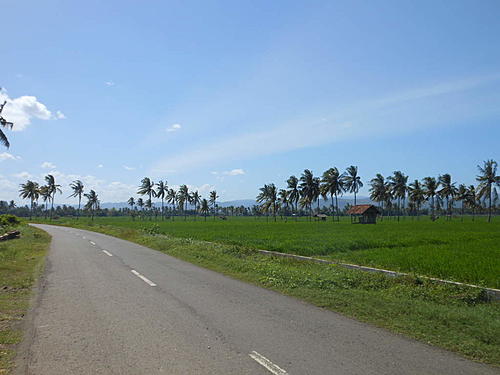
What she didn’t know was that there was a deal within the deal. The previous year in Bali I’d befriended Inez, a young woman originally from East Timor. As a tourist visa holder I could not register a bike in my name. But Inez was happy to lend me hers. She would have use of the bike when I returned home, and I would resume possession when I returned to Bali the following year. Seeing she would be riding it for nine months, I was prepared to put up with pink for four weeks. After completing the paperwork, we left the showroom, assured that the bike would be delivered next day.
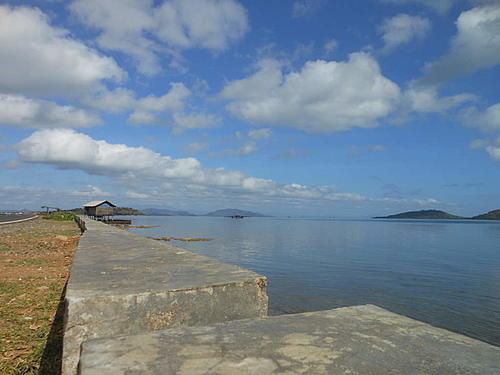
As promised, the bike - all shiny and pink - duly arrived at Inez’s rooming house. It still had to be registered, so Inez made her way down to the rego office, armed with some ‘readies’ to cover the required ‘fee’ to register Pinky on-the-spot . Next, she had a set of plates made up and off we went, riding around the back lanes of Kuta and Legian. She was like a kid with a new toy and pretty adept astride the bike, so I felt relaxed enough riding pillion. I baulked, though, when her mobile rang and she took the call. “Pull up,” I demanded. Inez obliged. When she finished the call, she turned to me and smiled. “Relax,” she said. “I might take calls when I’m riding, but at least I don’t text!” That was comforting. I had witnessed a number of people texting away whilst riding – a skill I’d not imagined existed before arriving in Bali!
Now, you might be wondering why anyone would embark on a major trip astride a pink egg-beater? Pink, I’ve explained. As for egg-beater? Well, it came down to this: cost, availability and practicality. Cost - I didn’t want to part with a lot of coin. Availability - if I’d wanted something bigger I’d have had to go to Jakarta. Practicality - although I carried minimal gear, a backpack weighing 13kgs - l didn’t want it on my back. So the Vario was perfect. The backpack sat snugly on the footplate, leaving room to plant a foot either side. In this way I felt both comfortable and balanced - important as I knew I’d be spending long hours on the road. I liked the automatic transmission on the Vario, and its lightweight was ideal. I planned to head way out, to that part of the map marked, ‘Thayre be dragones’, so, a mount that could easily be manhandled through mud, or sand or a dry, rocky creek bed would be ideal.
All formalities completed, I was free to go. I bade goodbye to Inez and at 7.00 on a Monday morning, I nosed out onto Jalan Padma to begin the trip. Traffic was already building on the narrow roads. A clever system of one-ways helped it flow through Legian to Kuta but it wasn’t long before I found myself surrounded by a crush of bikes, scooters, trucks, pick-ups and people movers, all jostling for position, horns blaring, honking and hooting to get through a bottleneck caused by road works. The southern third of Bali is home to 3 million people. I hadn’t realised they all left for work at the same time!
At the lights on Jalan Iman Bonjol I turned right for the By-Pass road that led to Sanur and onwards to Padangbai, the ferry terminal for Lombok, the next island east. Scooting along the wide, smooth by-pass at 65-70 kph was a joy. Slicing through the breeze, weaving past black-smoke-belching trucks, I found myself at ease, at last able to enjoy a little speed with some space around me. The scenery – a kaleidoscope of huge billboards, kampong houses, neat villas, factory lots and car showrooms punctuated by the occasional rice padi that had managed to resist the onward march of ‘development’ - fairly whistled by. Housewives were up and about sweeping their yards, and little schoolkids, resplendent in their crisp red and white uniforms, were gathering in knots on street corners or walking along, hand-in-hand, the younger ones being shepherded by older brothers and sisters.
I reached the major intersection with the road to Sanur. Every rider had the same idea – to ease their way to the front row of the grid. Trapped by the lights we waited amidst a suffocating mix of diesel fumes and carbon monoxide, blended with the wicked heat generated by the army of idling, impatiently-waiting engines. All eyes were glued on the lights to left and right, anticipating the flash of amber that would set engines revving for the ‘off’! And then it would be on - the race to get ahead of the pack! Being solo on a brand new machine, I had an advantage over those who were two up, and sometimes at the lights, I managed to generate clear road ahead of me. It wasn’t long though, before a half dozen Casey Stoner wannabees came screaming past on tricked-up machines emitting sufficient decibels to blow the needle off any EPA meter.
Beyond the Sukawati turn-off the country became a little more open. To the left were fields, and to the right, sky-blue waters lapped the black sand beaches. Riding was easier and more relaxing in the thinned-out traffic. Keeping an eye out for the occasional wandering Fido, wobbling cyclist or geriatric farmer entering the road from his yard without looking, I found myself soaking up the pleasures of the ride and loving being part of the landscape.
I swept on by, eager to make the ferry terminal at Padangbai. Passing along the narrow road, shaded by clumps of giant bamboo, banyans and immense fig trees trailing vines, was very pleasant; but catching up with slow-moving, overloaded trucks presented challenges that kept me on my toes. Labouring up the slightest incline each down-change caused these mechanical oxen to belch clouds of oily black smoke. Overtaking became an exercise in patience, positioning and timing with patience being the prime requisite. When opportunity presented itself a fist full of throttle would come into play. Most times I sailed past in clean air, but, there were occasions when my timing was awry and I’d find myself momentarily enveloped in a thick cloak of the oily, black stuff.
I reached the fork in the road I was looking for – Padangbai to the right, Candidasa to the left. I swung right and began the winding descent into the little port town. A few minutes later, I pulled up at Diane’s Cafe and ordered a coffee. The typed menu featured potatoes spelt three different ways, banana ‘paincakes’, (eat ‘em or slip on ‘em?), and drinks of all sorts. The ride had taken me an hour - heavy traffic for the first half and then half an hour dodging diesel smoke and weaving past trucks bound for the port and parts east. It had been a good test of patience, nerve and concentration. I was happy knowing that traffic would be less intense from now on.
I finished my drink and, refreshed, made my way into the port. Two plumpish cops sat at a small table. They called me over, examined my papers and then waved me on. I rode the short distance to join the knot of ferry-bound vehicles sitting on the quay. Waiting passengers milled around, smoking and laughing. Taxis disgorged families. A bus pulled up, brakes squeaking; a mob of back packers alighted from a mini- van. Young, blonde, suntanned and sunburnt, they looked half asleep - as if they’d been woken too early after a night out on the tear.
It was hot on the open dock. Many drivers had fired up their engines in anticipation. The air was thick with exhaust fumes. Superheated, it swilled around me like a toxic willy-willy. I made my way to some shade offered by a tiny kiosk around which squatted a number of women selling, snacks and cigarettes. In the water below plastic flotsam and jetsam washed gently back and forth between the pylons of the pier. On the rocky headland opposite stood the forlorn concrete skeleton of an abandoned South Korean resort project. Its owners had fallen foul of the appropriate authorities. Their dreams had disappeared down a black hole and now, the remaining evidence of their existence was being swallowed by the encroaching foliage. Vines had begun to wind their sinuous way around pillars and along beams – nature was reasserting itself.
The throng of restless passengers was stirring. Drivers revved engines impatiently. The harbour master, all piss and wind, arrived in a flurry of self importance, arms waving, gold-braid glistening. There was still one truck to disembark and the driver was in trouble. “Maju, maju, (Forward, forward),” bellowed gold-braid. The kid at the wheel, no more than a teenager, had stalled on the ramp. Gold-braid bellowed again. The kid looked panicked. He was making a spectacle of himself. No longer ‘King of the Open Road’, his inexperience was on view in some sort of grotesque overture to the commencement of the ferry ride. He attempted to re-start the engine but, in a fit of bloody-mindedness, it refused to fire. Meanwhile passengers had begun to surge on to the ferry and drivers began to toot their horns at the hapless teenage truckie. The din was intense. We’d been frying in the heat and patience was becoming Glad Wrap thin. Just when it seemed the battery would pack it in, the engine roared to life. First gear was slotted with a crash; engine gunned, the truck leapt forward like it had been stung from behind. The crowd cheered. The kid’s face, grin-split from ear to ear, registered his relief – from villain to hero in the twinkling of an eye! The truck reached the level surface of the dock and lumbered off on its way to Java.
Bikes and scooters roared forward to where the waiting crew were gesturing. Engine off, up on the centre stand. Helmet off, an arm hooked through the visor opening, I grabbed my bag and made my way to the narrow staircase to the upper deck to search for a cool breeze – a cool breeze to accompany us all the way to Lombok. She was waiting, barely five hours away across the warm, blue waters. It had been twenty three years since I’d last tasted her charms and I wondered if she was still as sweet as I remembered.
Last edited by kotamarudu; 1 May 2015 at 03:35.
|

15 Aug 2013
|
|
Registered Users
HUBB regular
|
|
Join Date: Aug 2007
Location: Australia
Posts: 64
|
|
|
Bali, Lombok, Sumbawa - a motorcycle odyssey. Lomnok Bound.
LOMBOK BOUND
The last vehicle, a wooden-sided Mitsubishi 3 tonner had just shoehorned its way into the only remaining space on the ferry’s vehicle deck. At a signal from the dock, the skipper gave the order to raise the loading ramp and the electric winches whirred into action. The crew, port authority staff and most Indonesian passengers, paid scant attention, but the young backpackers aboard crowded the rails to see the action below. The sound of winches was whisked away on a gentle breeze and replaced by two sharp blasts on the ferry’s siren. Waves broke on the rocky headland to port, sending plumes of spray skywards. The churning screws spat out a turgid, foaming, current of white water. We were on our way.
Passengers relaxed in the lounge watching violence-laden Chinese kung-fu movies, or risqué video clips featuring vampish Javanese singers belting out dangdut (Indian influenced pop music), hips gyrating with calculated and impressive vigour. Indonesia is renowned for its spices and these were indeed spicy performers.
Up on deck, passengers sought out the shade, slept, chatted, smoked and snacked, idling away the time between islands. Tiny Nusa Lembongan and its comparatively giant neighbour, Nusa Penida, slid by to starboard, and were soon behind us, as we steamed eastwards. At one point a pod of dolphins broke the surface and accompanied us for a few hundred metres before finding something better to do. Occasionally we would disturb some flying fish, and off they would go, skittering across the surface like stones skimmed across a pool. The sun beat down, plans were hatched, mobile numbers swapped, stories told, questions asked – all to the accompaniment of the engines’ hum. It wasn’t long before Lombok’s coast appeared. A haphazard line of low, green hills tumbled down to meet the sea. Jungle covered headlands separated tiny little bays where waves exhausted themselves against the beckoning shore.
Four hours into the trip and, little by little, the tiny port of Lembar began to take shape. Against a backdrop of large fuel tanks, warehouses and dock-mounted cranes, a dredge, three of four ferries and a host of tiny fishing boats with gaily-coloured triangular sails, rose and fell gently on the placid sea. Passengers stirred. I grabbed my gear and made my way below.
It was a tight squeeze getting to the bike. Vehicles, jammed one against the other, were somehow going to have to be disentangled. Plenty of riders were already mounted or busy strapping on bags. Trucks and busses fired up engines. The hold began to fill with fumes. We bike riders cursed. ‘Come on boys. Get the ramp down. We want out of here!’
The skipper inched us closer to the dock and the ramp began its slow descent revealing the waiting passengers and vehicles Lombok-side. A line was thrown and soon a massive rope was looped over a bollard. A slight jolt and clunk told us the ramp had locked into the dock – we were anchored. I eased my bike off the centre stand and started the engine. A white uniformed crew member began to wave us forward.
What an incredible sense of freedom you feel when accelerating away from the knot of taxi and mini-bus drivers who have gathered to greet the incoming passengers. Eager to separate them from as much of their hard earned as they can muster, do I see a slight licking of lips as the first back-packers begin to emerge from the vessel? A flick of my right wrist takes me beyond this unfolding scene and I am racing across the wide expanse of the car park, dodging pot holes, seeking the freedom of the exit gate and the road ahead.
Lombok. So close to Bali yet, by comparison so little visited, it doesn’t even warrant the appellation of ‘poor cousin’. But all that is about to change; Bali’s tourism bonanza cannot continue forever. Like every pounding wave that makes its way to the sun blessed sands of Kuta beach, it will run its course. The sun-and-fun seeking hordes will move on and Lombok’s recently completed international airport –when it eventually opens – is waiting to process them. Lombok offers friendly people and magnificent beaches, untouched by big bucks commercial development. I was there to enjoy them while I could.
I drove under the arch that announced, “Welcome to Lombok”, keeping an eye out for a petrol vendor. It wasn’t long before I spotted one - a little wooden stand sporting two racks of one litre bottles of ‘bensin’ and a sign – Rupiah 5000. At just five hundred above the pump price (5000 Rupiah is approx. 58 cents Australian a litre), only a scrooge would begrudge these enterprising householders their little profit margin. I pulled up. Out came an almond-eyed beauty from behind the roadside kiosk from whence she sold the knick-knack essentials of daily life. A smile from me elicited a dazzler from her. Out came the plastic funnel and a swirl of her delicate wrist set up a vortex which expelled the bottle’s contents in a flash. It was so deftly and gracefully done I called for another litre. Handing over the loot I said in my best Indonesian: ‘You’ve got style.’ Another dazzling smile sealed this brief encounter and sent me on my way. All was well with the world!
Traffic was light compared to Bali. But the same hazards were there – potholes, errant pedestrians, skylarking schoolkids – plus, an additional one. Lombok, being far less ‘developed’ than Bali, features dokars – little horse drawn carts – as a popular and cheap form of people and goods mover. And where you’ve got horses, you’ve got droppings - lots of them! The thought crossed my mind: ‘I wonder what the co-efficient of friction is between tyre rubber and a freshly deposited dollop?’ I didn’t want to find out the answer the hard way. Instead, I found myself keeping my eyes peeled, ever alert to flick the little Honda out of harm’s way – especially in the vicinity of markets where dokars were thick on the ground. The plan was to head for the old port city of Ampenam and snare a bite to eat at a roadside eatery or cafe in the market. After that I’d head north, 12 kilometres distant to the coastal strip of Senggigi Beach where I’d be sure to find accommodation for the night.
It wasn’t long before I reached Kediri, a town noted for its mosques and Islamic schools or madrassahs. A busy scene confronted me. The narrow main street was clogged with traffic. Police and parking officials did their best to unpick the tangle created by a dokar driver who’d lost part of his load of cane baskets and bags of rice. There was little to do but wait patiently and edge forward with the flow as, one-by-one, vehicles were ushered past the bottle neck. It was hot enough to fray tempers but no one unravelled or abused the hapless culprit as he laboured with his load.
Beyond Kediri the country opened up. I had entered the broad coastal plain that leads to Lombok’s major urban conglomerate – the conjoined cities of Ampenan, Mataram and Cakranegara. The road was wide, smooth and straight. It forged its way between padi fields whose serried rows of seedlings were so uniform you could be forgiven for thinking they’d been planted with the aid of a template. Lines of tall, ramrod straight coconut palms marched across the fields, denoting boundaries, and in the distance a jagged range of hills separated the tilled fields from the sea.
I passed a major intersection which allowed traffic coming from the west to join the Ampenam-bound stream. Traffic density flowing west increased markedly so overtaking became a lot more problematic. Patience rather than panache ruled the day. ‘Live fast, die young and leave a good looking corpse.’ was not a maxim I was inclined to take up - life is much too enjoyable to be snuffed out prematurely beneath the wheels of an on-coming truck. However, many young Indonesian riders had a touch of the James Dean’s about them, as they flashed by me at high speed, just managing to get back in and live to do it again a click or two down the road.
In the late afternoon I reached the narrow by-ways of Ampenam’s Arab quarter. I spotted a likely looking market. A phalanx of bikes was parked out front and the young guy who held the parking franchise waved me to a vacant slot. I dismounted and followed my nose to the smell of chicken satay being grilled over hot coals in front of a little stand. A stool, a bench, a hot black Lombok coffee in hand, polite inquiries as to where I was from and where I was headed, warm smiles and a plate of delicious food in front of me – what more could a lone traveller wish for?
Refreshed and re-invigorated I paid up, made my way to the bike park and paid my Rp.1000 (about 12 cents) parking fee. The young attendant retrieved my machine and then, with much whistle blowing, and arm waving, held up the traffic so I could blend smoothly into the flow heading north to Senggigi. Shortly after I was in amongst a tangle of vehicles weaving their way between the potholes and kicking up the dust - all eager to be free of the city and out in open country again.
The road north lay slightly inland from the sea. Nevertheless you could sense its proximity. Farmers drove their buffaloes home after a day’s ploughing; young boys kept flocks of noisy ducks in line and on the move, with the use of long bamboo canes. The roadside was alive with the commerce of village life – a barber shop here, a bike repair shop there, stalls selling coconuts, fruits and vegetables And everywhere, people on the way home at the end of the working day.
The first sign I was nearing Senggigi was as depressing as it was unexpected. A garish banner, strung across the road advertised ‘Club 69 Karoke.’ Silhouetted female forms cavorted against a yellow backdrop – a tawdry meeting of West and East each dragging the other down in a triumph of tastelessness. I drove on by, alert and watchful, looking for a hotel. Not long after, out of the corner of my eye, I spotted a small signboard: ‘Pondok Siti Hawa, Backpackers.’ I pulled up quickly, did a U-turn and drove in through the gates. A cobbled path wound its way through a lush garden. I pulled up at the side of the house and made my way around the back. There, relaxing on a raised platform, was Pak Husin, a New Zealander married to Siti Hawa. ‘Welcome brother,’ he said getting up to shake hands. ‘Siti Hawa,’ he called. ‘Ada tamu.’ (A guest has arrived). Seconds later a beaming Siti Hawa appeared from the kitchen. I liked her straight away. ‘Mari, mari,’ she gestured and we made our way through her lush garden to a small, stone, brick and bamboo bungalow. Self-contained with a thatched roof, it was perfect for my needs. I threw my gear on the bed and Siti rushed off to put the coffee on.
The sea was 30 metres away at the edge of the garden. I strolled along the narrow path which ended at a gap in the greenery. The golden sands curved away to left and right extending as far as the eye could see. The waves expired with a gentle hiss. There in front of me, just across the strait, lay Bali, its holy mountain, ‘Gunung Agung’ the ‘Great One’, rising majestically out of the sea. The sand, sea and sky were suffused with the red/yellow glow of the setting sun. I thought to myself: ‘How lucky am I? I’ve just left the ‘Island of the Gods’, and now I’ve stumbled upon a little corner of Paradise.’
Please note:
Lombok's International Airport at Praya (LOP) has been open 12 months now and Lombok is getting busier. There are direct flights daily from Singapore and KL and in Sept 2013 direct flights from Perth will begin'
In June 2013 the cost of petrol rose from IDR4500 per litre to IDR6500 per litre. One thing that hasn't changed though is the graceful 'swirl of the wrist' - every time I witness it that almond-eyed beauty appears in my mind's eye like a genie..
Last edited by kotamarudu; 16 Aug 2013 at 07:40.
Reason: Update
|

15 Aug 2013
|
|
Registered Users
HUBB regular
|
|
Join Date: Aug 2007
Location: Australia
Posts: 64
|
|
|
Bali, Lombok, Sumbawa - a motorcycle odyssey. Laid Back in Lombok.
Laid Back in Lombok.
The muezzin’s call to prayer hung in the still air while he paused to take breath. Each succeeding verse seemed to increase in dramatic intensity and the silence that reigned when the last note faded was total. It was 4.30 am or thereabouts. The Sasaks of Lombok are Muslims so, if you’re a light sleeper, either choose your lodgings well away from the local mosque or, be prepared to find ways to fill in your early mornings.
I went straight back to sleep and it wasn’t until the roosters started up, about an hour later, that I stirred. An early morning swim to wash the cobwebs away seemed like a good idea. The beach began at the bottom of the garden, twenty metres from my veranda – now that’s convenient!
The sea was flat and lazy. I cut a swathe through its restfulness and swam to a buoy about 100 metres off shore. Looking back to land the scene was straight out of Conrad – a palm fringed beach, golden sand, a minaret poking skywards, smoke from a cooking fire, rising above the tree line, then curling lazily south before disappearing against the background of a rapidly lightening sky. A fisherman passed in his catamaran, outboard motor idling. A seabird wheeled above, scanning the sea with a practised eye, its mournful cry caressed shore-wards by a zephyr. A car horn hooted. Daybreak had arrived.
I swam back in and took a shower. By the time I’d dressed my host Siti Hawa had prepared breakfast – a golden brown banana pancake, covered with lashings of honey with a wedge of lemon on the side so as to bring the entire ensemble of taste buds into play. A pot of steaming hot, freshly brewed, Lombok coffee and a bowl of papaya, banana and pineapple completed this feast. I might have left Bali, the island of the Gods, but sure as hell I had washed up in a little corner of Paradise – Pondok Siti Hawa Backpackers – Shangri-La by the Sea! Totally relaxed I kicked back and began to plan the activities for the day.
First on the agenda was to give the bike a once over and a wash, then a trip into Senggigi to get my bearings, check out the restaurants and bars and maybe have a spot of lunch. A bucket of water and a rag were borrowed and before long the accumulated grime and grit of the previous day’s riding was despatched to the dustbin of history and I had a new looking bike again. Fluid levels all OK, I was ready for the road.
It was good to be riding without carrying any gear on the footplate. Just having that little bit more room to change position made a difference to the comfort factor of the machine. The 4km ride was over in no time. It took me along a busy coastal road with the sea, and a string of 3 star hotels on the left and farm land and modest dwellings, set among coconut trees and vegetable gardens, on the right.
The approach to Senggigi town took me beneath a series of colourful banners strung across the road advertising the good time to be had at Club 69 Kareoke. “Happy Hour 8 – 9pm. Drinks ½ price. Thursday Nite: Ladies - Free Entry.” It was all happening at Club 69 that was for sure. I wondered how this sat with the local imams - a little awkwardly perhaps. But, then again, Indonesia is full of surprises and contradictions. The world’s most populous Muslim nation boasts among its national TV stars Nona Gunawan, a drag queen of muscular, if a little portly, physique whose popularity as a TV host, and 5-star celeb, is unrivalled. One gets a very different impression of Islam when the camera captures his audience, many of whom are be-scarfed Muslim women, rolling in the aisles at his bawdy double-entendres.
There was not a lot to see or do in Senggigi: a few boutiques displaying overpriced clothes, a clutch of tourist restaurants advertising overpriced meals, bars with boards out front advertising live music and a collection of dive shops and travel agents. They were all touting for custom from the available pool of tourists passing through, or just hanging out on their three week European summer breaks. Slim pickings indeed, as I saw only a handful of prospects strolling along the main drag. There were lots of ‘Accommodation Available’ signs on display. A sign advertising ‘Live AFL’ found me pulling up outside ‘The Office’ bar set adjacent to the beach and reached via a virtually deserted modern shopping mall.
The bar featured a large screen showing MTV clips. The patrons were exclusively ex-pats and their Indonesian wives and kids. Seeing these half dozen blokes in their 50s hunched around a table drinking  while their pretty, and much younger, wives sat on a bench along the wall chatting, while keeping an eye out on the kids, made me think that here were couples leading parallel lives. The men ignored the women and they returned the favour: hopefully their domestic situations were more blissful. I downed a cold Bintang and left feeling slightly depressed. Perhaps a game of footy on the big screen would have enlivened my spirits.
Back at Pondok Siti Hawa I spent my time swimming, eating and relaxing. Pak Husin had washed up on Lombok’s shores a quarter of a century ago after an expensive divorce settlement. He fell in love with the place, found his ideal partner, Siti, and they raised two sons. A dedicated environmentalist, into recycling and passionate about rubbish, he proudly tells guests that, ‘around here I’m known as the rubbish man.’ He has pioneered the collection of rubbish from the beach and the town area, beginning in a modest way and always looking to spread the word about the need to keep Senggigi clean. We spent many an hour yarning on the back veranda sitting on the chairs he’d made out of re-cycled car tyres. A man comfortable in two cultures he really conformed to the image of someone who had ‘gone native’. And good luck to him; he had carved out a very pleasant life for himself.
After a few very enjoyable days I made my farewells and rode out the gate, promising to drop by on the return journey. My route took me north around the coast – destination Labuhan Kayangan and the ferry that would take me to Poto Tano, ninety minutes away on the island of Sumbawa. The morning was crisp and clear and winding my way around the coastal road was sheer joy. A succession of superb little bays indented the coast, and the road, which climbed high above the sea, or dipped down to caress the shore, afforded superb views across to Bali and later, towards Kalimantan which lurked beyond the blue horizon. The countryside became notably drier and more sparsely populated as the road reached the northern limits of the island and began to bend eastwards. There were no green rice paddies anymore; just fields of corn and cassava interspersed with paddocks full of bushy scrub capable of sustaining goats but little else.
The heat rose with the sun; it was time for a drink. I pulled up at a little stall that sold petrol, snacks and nick-knacks and ordered a coffee. The young woman operator was a widow who, like millions of Indonesian women had spent time working overseas as part of TKI – Tenaga Kerja Indonesia or Indonesian Labour Power. She’d been employed in a Malaysian factory and had saved enough money to erect her modest stall, stock it and thus provide an income for herself and her two kids. Unless you’ve worked for the government there’s no social security so people and their families have to take care of themselves. Just to get by you have to be resourceful and resilient and Indonesians – by necessity - display these qualities in spades.
I rode on hoping to time my arrival at the port with the departure of the ferry. I knew they ran 24 hours a day but had no idea of the schedule. The road was practically deserted. Over to my right the land rose steadily, but gently, before disappearing into the low grey cloud that obscured the massive bulk of Mt. Rinjani, a 3700m active volcano. I ascended a low break in the hills and was confronted with a sparkling vista – the waters of Alas Strait glistening in the afternoon sun. Kayangan port and the ferry to Sumbawa beckoned. The little Honda seemed to quicken pace a little, eager to reach Sumbawa and come to grips with whatever surprises it had in store for us. Lombok had been laid back and languid maybe Sumbawa would be the same – we were about to find out!
Please note.
Since writing this piece, sadly Pak Husin has passed away – a good man with a strong community spirit who will always be fondly remembered.
|

15 Aug 2013
|
|
Registered Users
HUBB regular
|
|
Join Date: Aug 2007
Location: Australia
Posts: 64
|
|
|
Bali, Lombok, Sumbawa - Helter Skelter Across Sumbawa
HELTER SKELTER ACROSS SUMBAWA
I was the only tourist on the little JM Ferry –“We Serve Indonesia” – as it slid between the two spits of land guarding the narrow entrance to Kayangan harbour. Destination – Sumbawa, two islands east of Bali. We began to glide eastwards over a tranquil sea. It was mid-afternoon and the heat was intense. Shards of sunlight leapt off each tiny ripple of sea generating an eye-squinting glare. Lombok, its smouldering volcano, Rinjani, obscured behind a thick veil of cloud, began to recede to stern. To starboard a succession of tiny, rocky islets poked their heads up, strung out like irregularly spaced beads in a jagged necklace. Dry and devoid of vegetation, save for squat scrub and dun-coloured grass, the golden beaches of these uninhabited land specks looked perfect for the concealment of a hoard of pirate treasure.
Bali receives a couple of million tourists each year whereas Sumbawa, two islands east, would be lucky to see ten thousand – and that suits me just fine. Part of the reason for this imbalance is its isolation; part is due to lack of tourist infrastructure. And part is due to some unflattering and wildly exaggerated comments in an early guidebook which painted Bima, the main town, as a hotbed of Muslim fanatics. Its unsavoury reputation was earned wholly because it was the birthplace of a group of would-be assassins who (with some evidence of connivance by the CIA) attempted to bring the life of Indonesia’s first President, Soekarno, to a premature end. Thus from the early 70s, when they first reached these parts, Western travellers tended to avoid Sumbawa, or just hurry on through to more congenial islands further east. Consequently Sumbawa, a gem of an island, boasts large parts that have never seen a tourist. Not a single one of its pristine beaches has ever played host to a deck chair or, been stabbed by a beach umbrella.
After an hour’s sailing the Sumbawan ferry terminal came into view. We edged closer, and the smudge that is Poto Tano gradually took shape. An unremarkable dot on the map it consisted of a few warehouses, a couple of mobile phone towers, some scattered dwellings and an abandoned market. Its grey, concrete stalls stood, sullen and forlorn, staring out to sea, scanning the waves for the expected boatloads of customers who never came.
I was first bike off the ferry. A fist full of throttle saw me zing along the curving exit road that led to the port gates and the adventures ahead. Two k’s into the island and I came to a T-intersection: Sumbawa Besar to the left Taliwang to the right. I headed right into a landscape desiccated by heat and the salt borne by onshore winds. Nothing could grow here. A few hardy souls picked their way through the mud flats and shallow pools looking for marine edibles. Stick figures against the backdrop of a shallow bay, sarongs drawn up to their knees, skin blackened by the sun, they bore witness to life’s harsh struggle in this unforgiving backwater. Their tiny homes were flimsy structures of thatched walls with nipah palm roofs. They didn’t appear capable of withstanding a half decent wind and most likely were re-built at the conclusion of each big storm.
After a while the road left the coast and climbed to a pass through some low, rugged hills – snake country. The valley beyond was broad and green with fields of corn and padi bordering a meandering stream. Women worked the land. They waved as I passed by. Traffic was scarce and I had little to do except enjoy the pleasure afforded by the ever changing vista of the open road which stretched before me – a magnetic presence pulling me towards the next stop on my journey – Taliwang. This town is famous for a dish known widely throughout Indonesia – ayam Taliwang or Taliwang chicken – and I was keen to sample it in its birthplace.
I pulled up outside a smart looking eatery in the main street and placed my order. Twenty minutes later I was tucking in to the fieriest chicken dish I’d ever tasted. It was literally covered in a red chilli-based sambal. Each mouthful was interspersed with a large spoonful of plain white rice and a slug of water. It was as tasty as ... and as hot as!
It was now late in the day and I had to get a move on to reach Maluk by nightfall. The road passed through pleasant farmland and the occasional tidy village. Then it climbed again through rugged hills, twisting and turning, following the contours to a high point before zig-zagging down to the next valley. Progress was painfully slow as the steep ascents and descents, coupled with poor drainage, meant that the road was no match for the short but savage monsoon rains that fell in these parts. These left the surface so badly gouged and eroded that I was forced to ride at walking pace over the worst sections – trials riding on the bitumen, or what was left of it!
Ten kilometres before Maluk the road straightened out and the potholes disappeared. It had been built courtesy of Newmont Mining, operators of the massive Batu Hijau gold and copper deposit located about 25 kilometres inland from the town. This operation, which began in the early 90’s turned Maluk from a tiny village into a boom town, as hundreds of ex-pat miners and engineers flooded in to build the roads and infrastructure needed for such a huge undertaking. Most have now moved on, or have been replaced by locals, so the town has reverted somewhat to type.
I headed for the Kiwi Bar and booked a room. I was the only guest. Sitting in the bar, an icy cold Bintang in hand, in was not hard to imagine what the place would have been like in full swing. The walls were festooned with stickers extolling the virtues of “CAT Diesel Power”, “Atlas Copco”. ‘Ingersol Rand Compressors”, “GM”, “Hitachi”, “Komatsu”and “Cummins”. There was an impressive photo of a gigantic python laid out on the back of a truck. Its belly sported a massive bulge which belonged – according to whoever was telling the story - to a pig or a child. Either could be true. I’ve seen a photograph of a snake that had managed to ingest the torso of a man leaving his legs protruding from its gaping jaws, as if to advertise the awfulness of the poor fellow’s death.
I spent a few days in Maluk, swimming, wandering the beaches and exploring the magnificent coastal scenery. The Honda really impressed me with its ability to handle the rough going. It took me to places a much bigger bike would have had trouble reaching simply because it would have been too heavy to manhandle around, or over, some of the obstacles encountered. Goat tracks, buffalo trails, paths through the scrub, dry creek beds – the little Honda was a willing explorer which never let me down.
It was Saturday night. Back at the Kiwi Bar I was enjoying a convivial drink with some of the locals when I started to leaf through some magazines sitting on the bar. Out popped an AFL fixture. I quickly saw that the Western Bulldogs were playing the Lions at the Gabba next day. For sure the match would be shown on the Australia Network. The only problem was the nearest spot to pick up the telecast – the Blue Lagoon Bar at Hu’u Beach - was ¾ the way across Sumbawa. I thought to myself: “About 350 kilometres. Say eight hours riding at 40 kph average. If I leave before dawn I’ll probably make it in time.” Thus the plan was set. I was always up for a challenge and being a lifelong Bulldogs supporter this was one I could not shirk.
I finished my drink, went back to my room and packed my gear. A quick shower and into bed but getting to sleep was a different story. My mind was whirring, wondering what the next day would have in store for me. I tried to still my thoughts and take in the quiet sounds of the night instead. Eventually sleep came and I walked the street of dreams in blissful solitude.
I woke up with the first rooster just after 5 am. Half an hour later, on an empty stomach, I rode out of Kiwi’s gates and headed down the lane to the main street. Maluk was just stirring. A couple of shopkeepers were up sweeping their fronts, a bloke in his pyjamas walked a small child along the road, some horse carts trundled along to make their first pick-ups for the day. I filled up at the Pertamina servo on the outskirts of town and then headed north towards Poto Tano again.
The road took me past the Newmont complex at Benete Point where happily the stalls that had sprung up to provide the miners with early morning breakfast were in full swing. I ordered fried eggs, rice and coffee and sat down at a table. Workers came and went in quick succession, joshing each other and chatting up the waitresses as workers do. My breakfast arrived and I tucked in enthusiastically washing it down with the strong black Sumbawa coffee that would get me up and running for the challenge ahead.
Time to pay. I fronted the cashier, who I’d cast a discreet eye over whilst eating, handed over some readies and received my change. “There’s something I want you to remember,” I said. She paused for a moment. “What’s that?” she asked. “You’ve got a fantastic smile.” I replied. And with that she burst into the best smile you’ve ever seen. It’s always good to begin a journey with a happy memory as you never know how it’s going to end up! I jumped on the bike and headed off giving her a wave as I went on my way. She returned it with another dazzling smile. Just a small encounter on the road but one I’ll always remember.
Into the hills again but this time more prepared as I was re-tracing my steps. Traffic was sparse save for a few lumbering trucks and a couple of bikes. Before long I caught up to a couple of young blokes on a tricked up 125 Yamaha – clip ons, mag wheels, race tuned pipe, after market shocks. I passed them on a rough uphill section. Before long they passed me and on it went time after time. Good natured duelling in far western Sumbawa. As the road got better so did their fortunes. Real dare devils they launched themselves into the sweeping bends and attacked the hairpins with relish. I’d catch up on steeper, more pot holed sections and then it would be their turn again to fly past. Finally we reached the coastal plain. They gave me a wave and then tore on by. I didn’t see them again.
Approaching Sumbawa Besar after a two hour ride I saw a sign: ‘Dompu By-Pass’. I veered right. I turned out to be a bad mistake. The road was as rutted and broken as any I’d encountered, if not worse. Trucks bounced and bucked kicking up the dust. The road was wave like in its perambulations as it wound its way through the hinterland of the town. Fine dust and grit choked the air. Driven by a hot dry wind it smothered everything. I kept going driven by a determination to emerge from this dust cloud and breathe easy once again.
It was a good 30 minutes before the good bitumen re-appeared and led me to a T-intersection west of the town. I turned right towards Dompu and began the climb to the plateau. The next few hours were pure enjoyment. A good road, pretty farmland, busy little market towns without traffic jams, and then, beyond Teluk Santong, two hours of the most glorious coastal scenery as the road soared high above the sea clinging to the cliff side, then plunging down to the coast to cross the occasional dry river bed before climbing again. And, for the most part, other than the troops of monkeys that peered from the roadside, I had it all to myself. What a ride! It felt so good to be alive.
Around 1.00 pm I came around a bend high in the forested hills and beheld the splendid vista of the rich Dompu valley as it opened up below. The road hurtled down in a series of flowing bends, the air becoming noticeably warmer as the descent progressed. Before long I was at the at the T-intersection – Calabai and Mt. Tambora to the left, Dompu and Hu’u to the right. I swung right to Dompu town and stopped for a bite to eat – chicken satay – and a drink. Seven hours in the saddle and I was feeling the pinch; but only an hour to go.
I filled up and headed south over the river where women bent to their washing in the rocky bed, their kids bathing and playing beside them. On and on I went getting ever closer. Thirty k left, twenty-five. I was counting them down. And then I saw the first signs advertising accommodation. I was getting close now. I was headed for ‘Monalisa’ the first place on the right.
I pulled in. I got a warm welcome from Robbie, the manager, who remembered me from the year before. A quick shower, fresh tee shirt and shorts and it was straight down to the Blue Lagoon. Was my trip in vain? Would I suffer disappointment when my goal was in sight? I swung open the doors of Blue Lagoon. The big screen at the end of the room flickered to life with a talking head and the dulcet tones of Denis Cometti reached me from across the ether: ‘Good afternoon viewers and welcome to this round 15 clash between the Brisbane Lions and the Western Bulldogs at the Gabba. Beautiful day here in Brisbane, no wind to speak of, blue sky 23 degrees Celsius ...
Beautiful day at the Blue Lagoon too - and it got better. I ordered a  – the first of quite a few - and kicked back. The Dogs went on to win the game in a canter and I couldn’t have wished for a better ending to my day’s ride across Sumbawa – Indonesia’s sidelined island.
|

16 Aug 2013
|
|
Registered Users
HUBB regular
|
|
Join Date: Aug 2007
Location: Australia
Posts: 64
|
|
|
Bali, Lombok, Sumbawa - a motorcycle odyssey. Helter skelter across Sumbawa
Road update - August 2013.
I'm pleased to report that the road from Sape to Poto Tano is now in excellent condition as a result of an Australian Government Aid grant. Also the by-pass around Sumbawa Besar is now finished and the road from Poto Tano to Maluk is 90# AOK
|
|
Currently Active Users Viewing This Thread: 2 (0 Registered Users and/or Members and 2 guests)
|
|
|
 Posting Rules
Posting Rules
|
You may not post new threads
You may not post replies
You may not post attachments
You may not edit your posts
HTML code is Off
|
|
|
|

Check the RAW segments; Grant, your HU host is on every month!
Episodes below to listen to while you, err, pretend to do something or other...
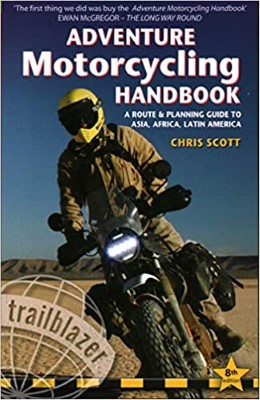
2020 Edition of Chris Scott's Adventure Motorcycling Handbook.
"Ultimate global guide for red-blooded bikers planning overseas exploration. Covers choice & preparation of best bike, shipping overseas, baggage design, riding techniques, travel health, visas, documentation, safety and useful addresses." Recommended. (Grant)

Ripcord Rescue Travel Insurance™ combines into a single integrated program the best evacuation and rescue with the premier travel insurance coverages designed for adventurers.
Led by special operations veterans, Stanford Medicine affiliated physicians, paramedics and other travel experts, Ripcord is perfect for adventure seekers, climbers, skiers, sports enthusiasts, hunters, international travelers, humanitarian efforts, expeditions and more.
Ripcord travel protection is now available for ALL nationalities, and travel is covered on motorcycles of all sizes!
What others say about HU...
"This site is the BIBLE for international bike travelers." Greg, Australia
"Thank you! The web site, The travels, The insight, The inspiration, Everything, just thanks." Colin, UK
"My friend and I are planning a trip from Singapore to England... We found (the HU) site invaluable as an aid to planning and have based a lot of our purchases (bikes, riding gear, etc.) on what we have learned from this site." Phil, Australia
"I for one always had an adventurous spirit, but you and Susan lit the fire for my trip and I'll be forever grateful for what you two do to inspire others to just do it." Brent, USA
"Your website is a mecca of valuable information and the (video) series is informative, entertaining, and inspiring!" Jennifer, Canada
"Your worldwide organisation and events are the Go To places to for all serious touring and aspiring touring bikers." Trevor, South Africa
"This is the answer to all my questions." Haydn, Australia
"Keep going the excellent work you are doing for Horizons Unlimited - I love it!" Thomas, Germany
Lots more comments here!
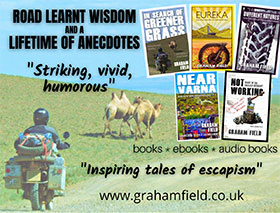
Diaries of a compulsive traveller
by Graham Field
Book, eBook, Audiobook
"A compelling, honest, inspiring and entertaining writing style with a built-in feel-good factor" Get them NOW from the authors' website and Amazon.com, Amazon.ca, Amazon.co.uk.
Back Road Map Books and Backroad GPS Maps for all of Canada - a must have!
New to Horizons Unlimited?
New to motorcycle travelling? New to the HU site? Confused? Too many options? It's really very simple - just 4 easy steps!
Horizons Unlimited was founded in 1997 by Grant and Susan Johnson following their journey around the world on a BMW R80G/S.
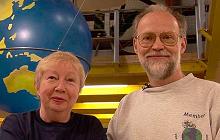 Read more about Grant & Susan's story
Read more about Grant & Susan's story
Membership - help keep us going!
Horizons Unlimited is not a big multi-national company, just two people who love motorcycle travel and have grown what started as a hobby in 1997 into a full time job (usually 8-10 hours per day and 7 days a week) and a labour of love. To keep it going and a roof over our heads, we run events all over the world with the help of volunteers; we sell inspirational and informative DVDs; we have a few selected advertisers; and we make a small amount from memberships.
You don't have to be a Member to come to an HU meeting, access the website, or ask questions on the HUBB. What you get for your membership contribution is our sincere gratitude, good karma and knowing that you're helping to keep the motorcycle travel dream alive. Contributing Members and Gold Members do get additional features on the HUBB. Here's a list of all the Member benefits on the HUBB.
|
|
|







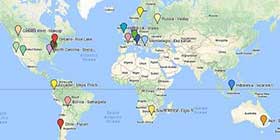











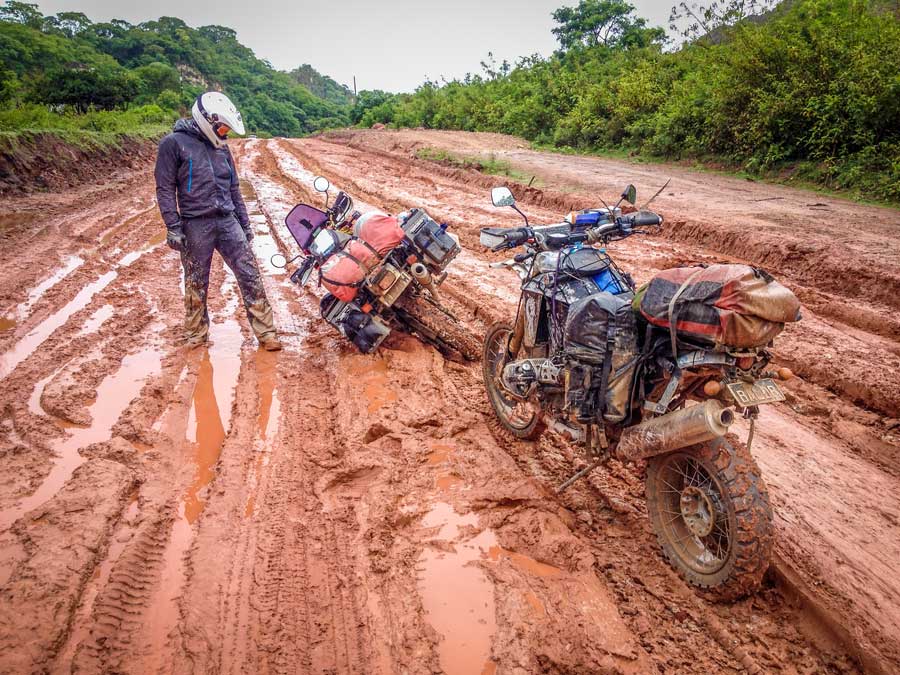











 while their pretty, and much younger, wives sat on a bench along the wall chatting, while keeping an eye out on the kids, made me think that here were couples leading parallel lives. The men ignored the women and they returned the favour: hopefully their domestic situations were more blissful. I downed a cold Bintang and left feeling slightly depressed. Perhaps a game of footy on the big screen would have enlivened my spirits.
while their pretty, and much younger, wives sat on a bench along the wall chatting, while keeping an eye out on the kids, made me think that here were couples leading parallel lives. The men ignored the women and they returned the favour: hopefully their domestic situations were more blissful. I downed a cold Bintang and left feeling slightly depressed. Perhaps a game of footy on the big screen would have enlivened my spirits.
 Linear Mode
Linear Mode









